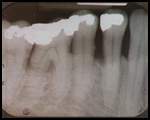

X-Rays
 |
| X-Ray of Teeth With Advanced Periodontitis |
X-rays, or radiographs, are used in dentistry to detect conditions which cannot be detected with the naked eye.
Because periodontal disease affects the supporting structures below the teeth -- the gums and bone -- a periodontist needs to have pictures of these areas.
An accurate X-ray or radiograph is essential for appropriate diagnosis and treatment. It is the only method of establishing a baseline or severity level of disease and of permanent documentation.
The type of X-rays we most often use in our office is called periapical X-rays. These X-rays determine the condition of the bone and gum tissue supporting the teeth and reveal pathology around the roots of the teeth. It is usually necessary for us to have a full mouth series of periapical X-rays on all our patients, either from a general dentist, or taken in our office.
Many of our patients have expressed concern about possible health risks from exposure to X-rays.
Dentists and dental auxiliaries are trained in taking X-rays with minimal hazard to the patient. Exposure is limited to the teeth to be studied. A lead apron is always placed over the torso of the patient to protect the body from secondary radiation. Our new high-speed films and X-ray machines reduce radiation, while the use of special focusing devices minimizes exposure to surrounding tissues.
We feel that a complete dental X-ray examination is essential to properly diagnose your dental needs. At the same time, we share your concern about possible health risks. By monitoring the frequency of the X-rays and taking the precautions mentioned above, we assure you that the risks are essentially negligible.
Information | Procedures | People | Our Office | E-Mail Us
Periodontal Associates | (303) 755-4500